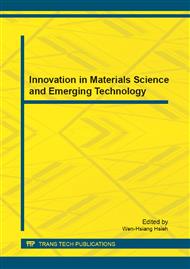p.1
p.6
p.11
p.16
p.21
p.27
p.32
p.37
p.43
Enhanced Coupled Field Modeling of PZT Cantilever Bimorph Energy Harvester
Abstract:
As consumer electronics continue to develop in size and scope, the battery power source with the limited life span poses an increasing economic challenge. This growing problem has motivated the development of the energy harvesters that can scavenge the ambient environment energy and convert it into the electrical energy for use of the wireless sensor nodes and the portable electronics. With the coupled field characteristics of structure to electricity, piezoelectric energy harvesters are under consideration as a means for converting the mechanical energy to the electrical energy, with the goal of realizing completely self-powered sensor systems. In this paper, the development of an enhanced coupled field model for the PCB energy harvester based on a previous model in the literature using a conservation of energy method is presented. Further, the laboratory experiments are carried out to evaluate the enhanced coupled field model and the other two previous models in the literatures. The comparison results show that the enhanced coupled field model can better predict the open-circuit of the PCB energy harvester with a proof mass bonded at the free end of the structure in order to increase the energy harvesting level of the system.
Info:
Periodical:
Pages:
21-26
Citation:
Online since:
December 2011
Authors:
Keywords:
Price:
Сopyright:
© 2012 Trans Tech Publications Ltd. All Rights Reserved
Share:
Citation:


